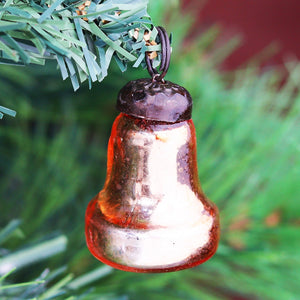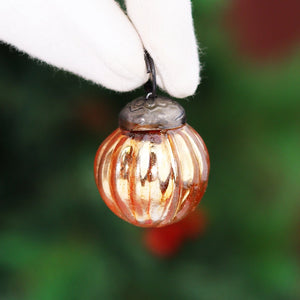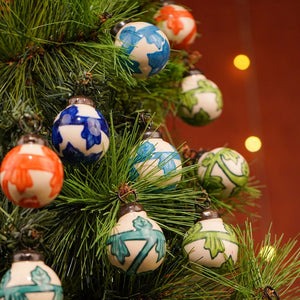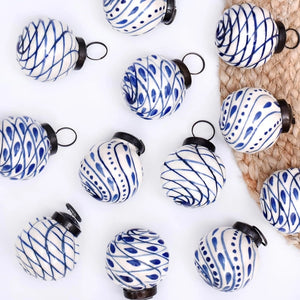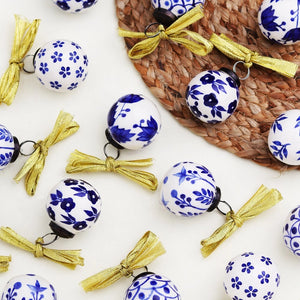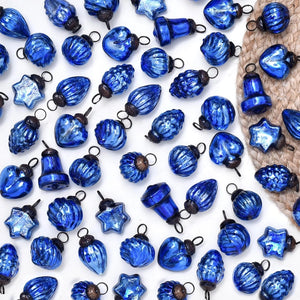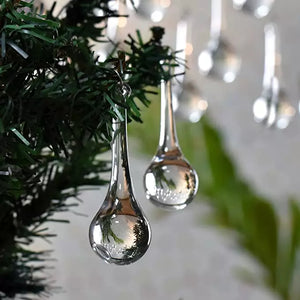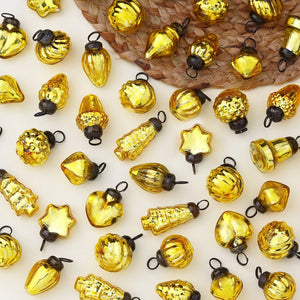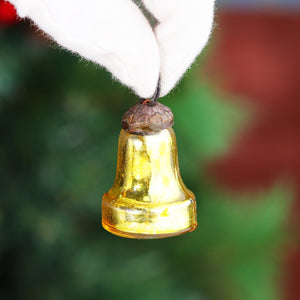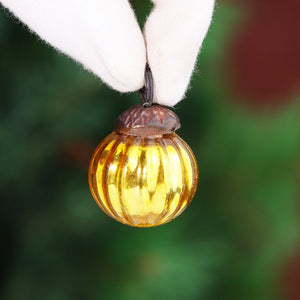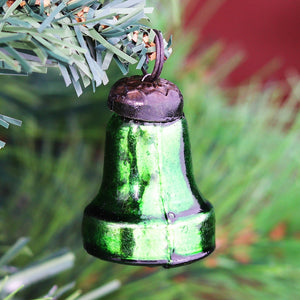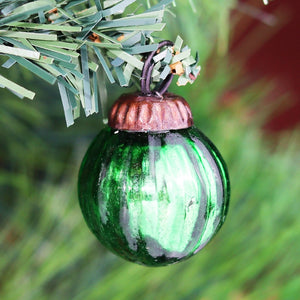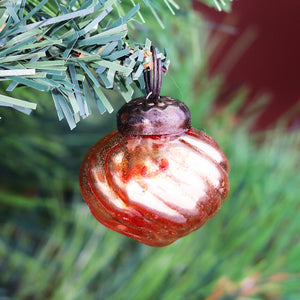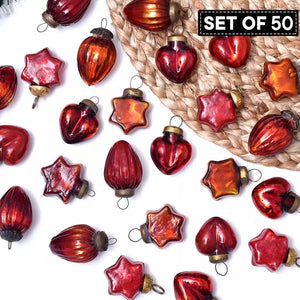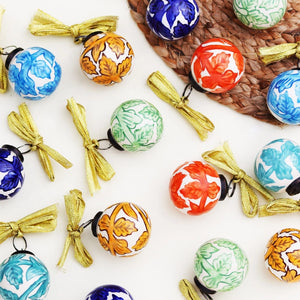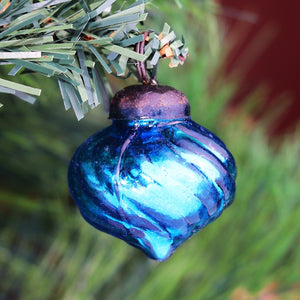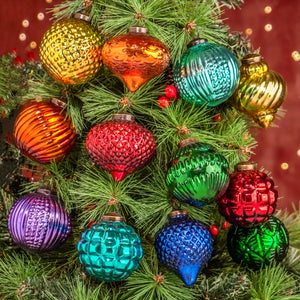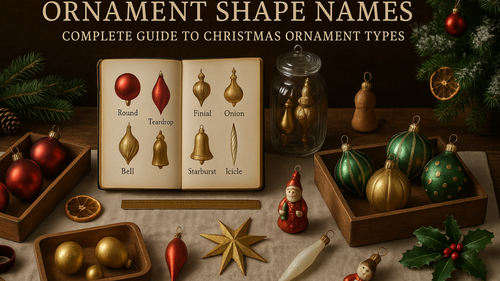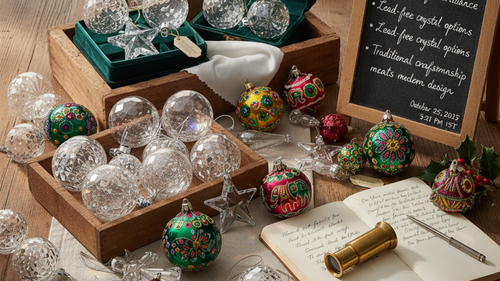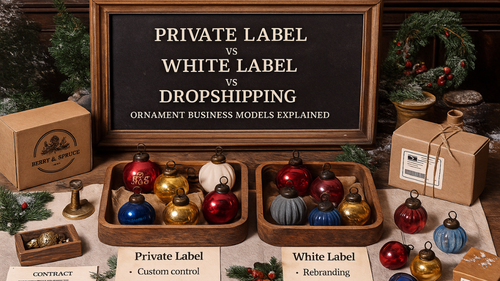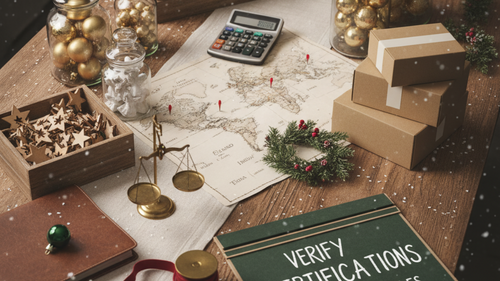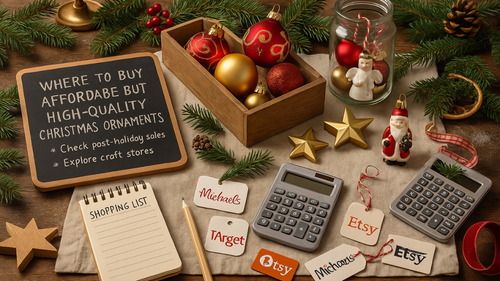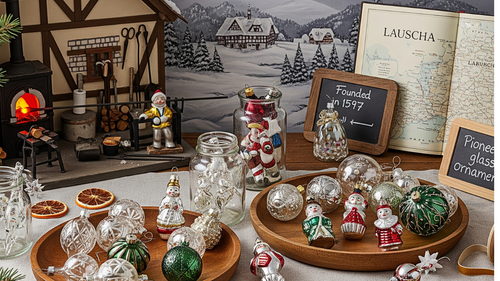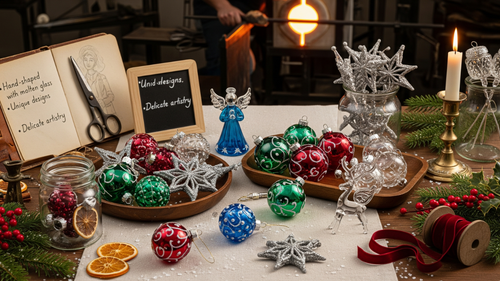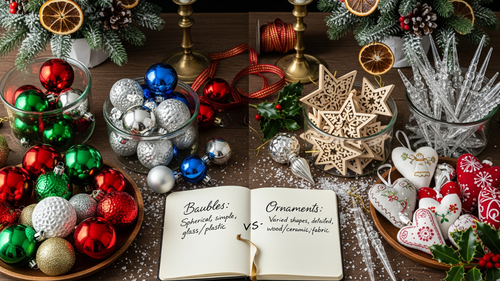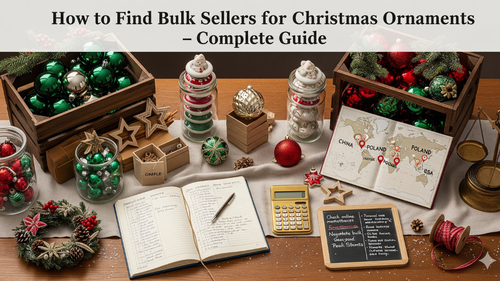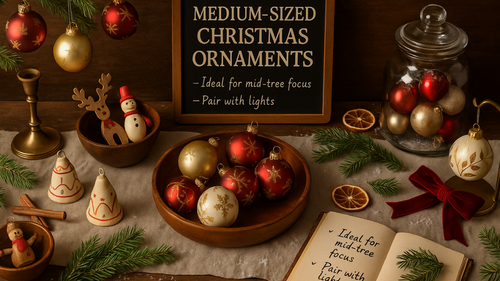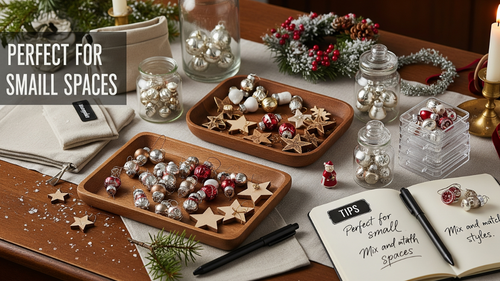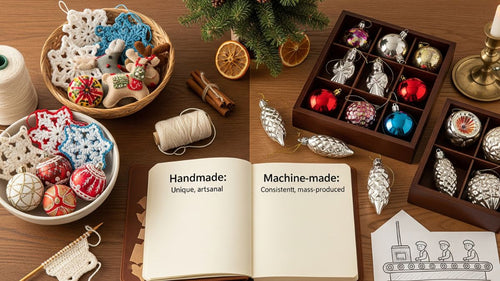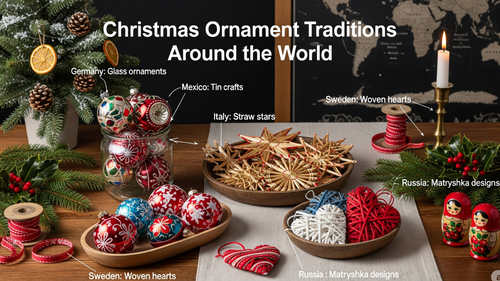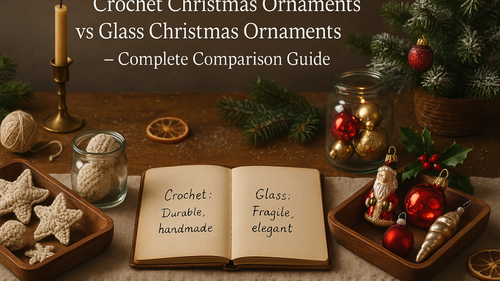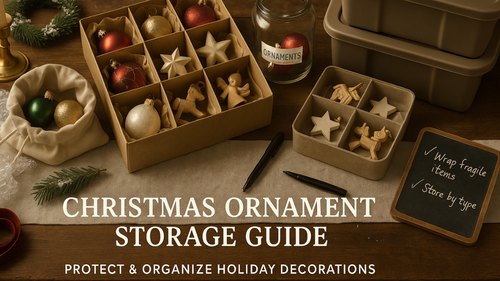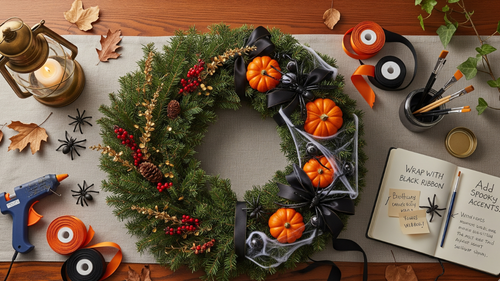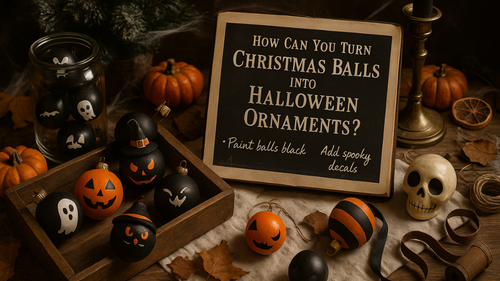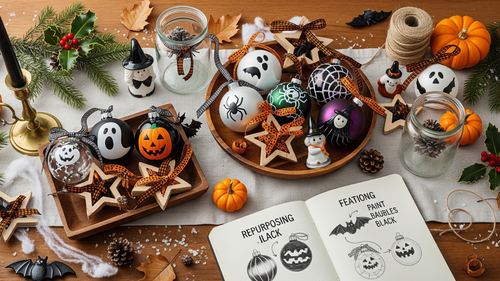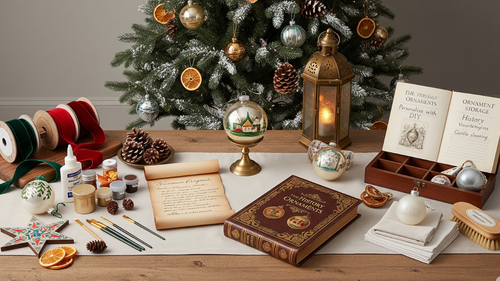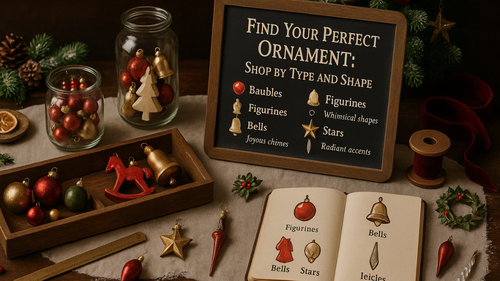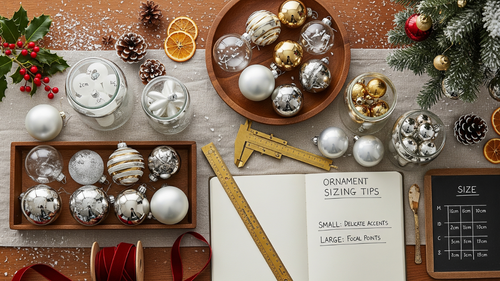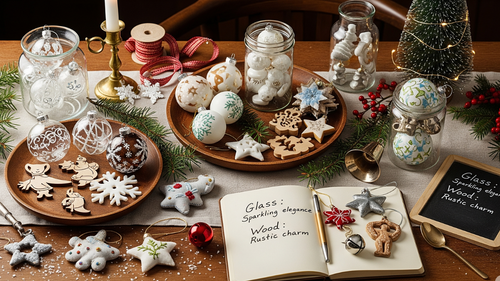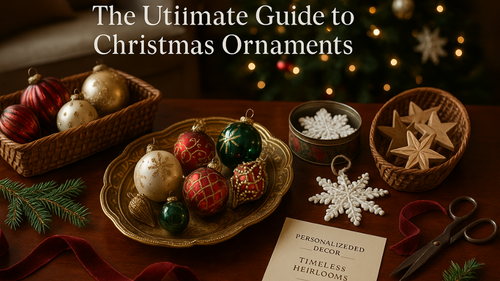Glass ornaments transform ordinary spaces into enchanting displays, whether adorning your holiday tree or serving as year-round décor accents. These delicate treasures—from hand-painted heirlooms to modern glass ornaments—demand careful maintenance to preserve their brilliance and prevent irreversible damage.
According to 2024 conservation studies, improper cleaning remains the primary cause of ornament deterioration, with over 60% of vintage glass pieces losing value due to aggressive cleaning methods. The challenge intensifies when dealing with specialized finishes: mercury silvering, hand-applied glitter, antique Lauscha techniques, or delicate painted details that can vanish with a single wrong move.
This comprehensive guide reveals professional-grade cleaning techniques suitable for collectors and casual decorators alike. You'll discover material-specific approaches for crystal, blown glass, frosted finishes, and painted surfaces, alongside natural cleaning solutions that protect both your ornaments and the environment. Whether you're preparing ornaments for seasonal display or preserving family heirlooms, these tested methods ensure your glass decorations maintain their luster for generations.
Key Takeaways
- Always start with dry cleaning methods before introducing any moisture to glass ornaments
- Never soak decorated ornaments—water can seep beneath paint, glitter, or silvering and cause irreversible damage
- Use distilled water instead of tap water to prevent mineral deposits and watermarks on glass surfaces
- Avoid ammonia-based cleaners which can strip paint, tarnish metallic finishes, and damage vintage silvering
- Handle ornaments with cotton gloves to prevent fingerprint oils and reduce breakage risk
- Test cleaning solutions on inconspicuous areas before applying to visible surfaces, especially on antique pieces
- Air-dry ornaments completely in a cradle or on padded surfaces—never use heat or force-dry
- Store cleaned ornaments immediately in individual compartments to prevent dust accumulation and scratching
Why Proper Glass Ornament Cleaning Matters
Glass ornaments represent more than seasonal decorations—they embody memories, traditions, and often significant financial investment. Proper cleaning directly impacts three critical factors:
Preservation of Value and Beauty
The market for vintage and handblown Christmas ornaments has grown substantially, with certain antique pieces appreciating 15-20% annually according to 2024 collectibles market reports. A single cleaning error can reduce an ornament's value by half or render it worthless. Hand-painted designs, mercury glass silvering, and vintage Lauscha glass finishes prove particularly vulnerable to improper techniques.
Prevention of Common Damage
Three types of deterioration plague improperly cleaned glass ornaments:
Featured Products
- Paint flaking and peeling: Occurs when water or solvents penetrate between glass and decorative layers
- Glitter loss: Results from friction during cleaning or adhesive breakdown from harsh chemicals
- Silvering tarnish: Develops when moisture enters the ornament's interior through cracks or openings
Safety During Handling
Glass ornaments demand respect during cleaning. Working over padded surfaces, using appropriate tools, and avoiding heat exposure prevents injuries and breakage. These precautions become essential when cleaning entire collections or preparing dozens of ornaments for display.
Understanding Different Types of Glass Ornaments
Identifying your ornament type determines the appropriate cleaning approach. Each category requires specific care considerations based on manufacturing method, finish, and age.
Clear and Colored Glass
The most durable category, clear and solid-colored glass ornaments tolerate gentle washing. These pieces typically feature paint or decoration only on exterior surfaces, making them suitable for mild soap solutions and water-based cleaning.
Featured Products
Frosted and Textured Glass
Frosted finishes result from acid etching or sandblasting, creating a porous surface that traps dirt and moisture. These ornaments require exclusively dry cleaning methods, as water darkens the frosted appearance and leaves permanent marks.
Hand-Painted and Decorated
Hand-painted ornaments represent the highest risk category. Paint layers often lack protective sealants, making them vulnerable to water damage, solvent exposure, and physical abrasion. When shopping for quality decorated pieces, consider sources like glass ornament collections that specify paint durability and finish type.
Mercury Glass and Silvered Interiors
Authentic mercury glass (actually silver nitrate, not mercury) predates 1940 and commands premium prices. The silvering sits inside the glass, accessible through a small opening typically sealed with wax or cork. Any moisture reaching the interior causes immediate, irreversible tarnishing. Modern reproductions use aluminum or other metals but require identical care.
Featured Products
Crystal and Cut Glass
Lead crystal ornaments exhibit exceptional brilliance but show every fingerprint and water spot. These pieces benefit from specialized crystal cleaning methods rather than general glass cleaning approaches.
Blown Glass and Art Glass
Traditional Lauscha-style blown glass ornaments feature thin walls and delicate construction. Handle these pieces with extreme care, supporting from below and avoiding pressure on any single point.
Essential Materials and Safety Precautions
Successful ornament cleaning begins with proper preparation. Assemble these materials before starting any cleaning session:
Required Cleaning Supplies
- Microfiber cloths: Multiple clean cloths dedicated exclusively to ornament care
- Cotton gloves: White cotton prevents fingerprints and provides better grip than bare hands
- Distilled water: Eliminates mineral deposits that tap water leaves behind
- Mild dish soap: pH-neutral formulas without degreasers, fragrances, or moisturizers
- Soft natural-bristle brush: Artist brushes or makeup brushes for detail work
- Cotton swabs: For targeted cleaning around caps and hangers
- Isopropyl alcohol (70%): For spot cleaning and disinfection
- Padded work surface: Thick towels, foam pads, or specialized jewelry trays
Safety Guidelines
Follow these precautions for every cleaning session:
- Work in well-ventilated areas when using alcohol or cleaning solutions
- Never apply heat—no hair dryers, radiators, or direct sunlight during drying
- Avoid ammonia-based cleaners entirely, including common glass cleaners like Windex
- Keep ornaments away from sink edges and hard surfaces
- Remove jewelry that could scratch glass surfaces
- Clean one ornament at a time to prevent mixing techniques or solutions
- Have a designated container for damaged ornaments requiring professional restoration
Common Materials to Avoid
These seemingly harmless items cause frequent ornament damage:
- Paper towels: Contain wood fibers that scratch glass
- Regular towels: Leave lint and may harbor abrasive particles
- Household glass cleaners: Ammonia content damages finishes
- Hot water: Temperature shock can crack thin glass
- Abrasive sponges: Even "gentle" scrubbers create microscratches
Basic Cleaning Techniques for Glass Ornaments
Master these fundamental approaches before attempting specialized cleaning methods. Start with the gentlest option and progress only if necessary.
Dry Dusting Method
The safest cleaning approach removes 80% of common dirt without moisture. Use a clean microfiber cloth or soft natural-bristle brush to gently whisk away dust. For ornaments with intricate details, a clean makeup brush reaches crevices without applying pressure. This method works for all ornament types and should precede any wet cleaning.
Pro Tip: Dry clean ornaments before storing them each season—this single step prevents 90% of storage-related deterioration.
Mild Soap and Water Method
For undecorated or sealed-surface ornaments only:
- Mix three drops of mild dish soap per cup of room-temperature distilled water
- Dampen (don't soak) a microfiber cloth in the solution
- Wring the cloth until barely moist—it should not drip
- Gently wipe the ornament surface using circular motions
- Immediately follow with a dry microfiber cloth
- Air-dry completely on a padded surface before handling
Never submerge ornaments in water, even briefly. Liquid seeps through microscopic cracks and causes internal damage invisible until the ornament begins deteriorating weeks later.
Rubbing Alcohol Spot Cleaning
Isopropyl alcohol (70% concentration) excels at removing fingerprints and skin oils from plain glass surfaces:
- Dampen a cotton swab with alcohol
- Gently dab the soiled area—never rub in circles
- Allow alcohol to evaporate naturally (15-30 seconds)
- Buff with a clean microfiber cloth if needed
Test alcohol on a hidden area first, as it can dissolve certain paints and adhesives. Never use alcohol on frosted, painted, or glittered surfaces.
Vinegar Solution for Plain Glass
A mixture of equal parts distilled water and white vinegar cuts through water spots and film on undecorated glass. Apply with a damp cloth, then immediately dry. This solution proves too acidic for painted, metal-trimmed, or antique ornaments.
Microfiber Polishing Technique
After cleaning, restore shine using a dry microfiber cloth with light circular motions. This technique works particularly well on different ornament materials, though glass benefits most from the friction-generated static that lifts remaining dust particles.
The Breath-Fog Method
Professional glass cleaners use this technique for final polishing:
- Hold the ornament 2-3 inches from your mouth
- Exhale gently to create a thin fog layer on the glass
- Immediately buff with a microfiber cloth in circular motions
- Repeat if necessary for stubborn smudges
This method requires no solutions and works brilliantly for last-minute touch-ups before displaying ornaments.
Deep Cleaning Methods for Heavily Soiled Ornaments
Ornaments stored improperly or exposed to smoke, dust, or environmental contaminants require more intensive cleaning. These methods address stubborn issues while minimizing risk.
Soaking Undecorated Glass Ornaments
Plain glass spheres without paint, glitter, or internal silvering can tolerate brief soaking:
- Fill a plastic basin with room-temperature distilled water
- Add one teaspoon of mild soap per gallon of water
- Submerge ornaments for no more than 60 seconds
- Lift ornaments individually—never pour them out
- Rinse each ornament under gently running distilled water
- Dry immediately with a microfiber cloth
- Place in a cradle or padded tray to air-dry completely
Warning: Check each ornament carefully before soaking. A single painted or silvered piece in the batch can contaminate the water or suffer irreversible damage.
Removing Sticky Residues
Price stickers, tape, and tree sap adhere stubbornly to glass. Address these issues using residue-specific approaches:
For Adhesive Residue:
- Apply a tiny amount of coconut oil to a cotton swab
- Gently rub the residue in one direction
- Clean away oil with soap and water method
- Dry thoroughly
For Tree Sap:
- Freeze the ornament for 30 minutes if possible
- Gently scrape frozen sap with a plastic credit card edge
- Remove remaining residue with rubbing alcohol
- Clean and dry normally
Smoke Film and Nicotine Removal
Smoke creates a yellowish film requiring specialized treatment. For plain glass only, mix one part white vinegar with two parts distilled water. Apply with a damp cloth, working in sections, then rinse and dry immediately. This process may require 2-3 applications for heavy buildup. Consider the time investment when acquiring affordable quality ornaments versus restoration projects.
Disinfecting Glass Ornaments
When ornaments require disinfection (after storage in damp areas or purchase from estate sales):
- Clean visible dirt using appropriate methods first
- Apply 70% isopropyl alcohol to plain glass surfaces only
- Allow 30-second contact time
- Air-dry completely—do not rinse
Never disinfect painted, glittered, or antique ornaments—cleaning must prioritize preservation over sterilization for decorated pieces.
Problem-Specific Cleaning Solutions
| Problem | Safe Solution | Avoid |
|---|---|---|
| Fingerprints | Rubbing alcohol on cotton swab | Circular scrubbing motions |
| Water stains | Distilled water + microfiber polish | Tap water (adds more minerals) |
| Sticky residue | Coconut oil on plain glass | Solvent on painted areas |
| Dust buildup | Dry microfiber or soft brush | Compressed air (too forceful) |
| Greasy film | Mild soap solution + immediate dry | Degreasing dish soap |
How Do You Clean Fragile or Antique Glass Ornaments?
Vintage and antique ornaments demand reverence during cleaning. These pieces often feature manufacturing techniques discontinued decades ago, making them irreplaceable. Conservation principles emphasize stabilization over restoration—when in doubt, preserve existing condition rather than risk improvement attempts.
Handling Protocols for Valuable Ornaments
Proper handling prevents 95% of antique ornament damage:
- Always wear clean cotton gloves—skin oils accelerate tarnishing on metal components
- Support from below using your palm, never grip from the top or sides
- Work one ornament at a time with full attention—multitasking causes accidents
- Keep hands dry—even slight moisture reduces grip security
- Move deliberately without rushing, maintaining awareness of surroundings
Cleaning Antique Mercury Glass Ornaments
Authentic mercury glass (silver nitrate coating) and vintage Lauscha glass ornaments require extreme caution. A single water droplet penetrating the interior causes silvering degradation visible within hours.
Safe cleaning protocol:
- Inspect the closure point (typically the top cap area) for gaps or damage
- Use only a soft, dry natural-bristle brush for dusting
- For exterior fingerprints on intact pieces, dampen a cotton swab with minimal distilled water
- Dab gently—never wipe across the surface
- Dry immediately with a soft cloth
- If silvering shows any flaking or dark spots, cease cleaning and consult a professional
Many collectors prefer leaving minor dust on mercury glass rather than risking water damage. This conservative approach preserves value better than overzealous cleaning.
Hand-Painted Antique Ornaments
Paint on vintage ornaments often lacks modern protective coatings. Test any cleaning method on an inconspicuous area first:
- Use exclusively dry cleaning methods unless absolutely necessary
- Never apply liquid directly—always dampen a cloth first
- Avoid friction across painted areas entirely
- Pat or lift dirt rather than wiping
- Accept stable dirt over paint loss—originality matters more than appearance
When to Stop Cleaning
Recognize these warning signs indicating you should cease cleaning immediately:
- Paint beginning to lift or feel soft
- Glitter releasing from surface
- Color transferring to your cloth
- Glass surface feeling rough or textured where it was smooth
- Any darkening or discoloration appearing during cleaning
- Cracking sounds (even barely audible)
Antique ornaments sometimes reach a condition where cleaning causes more harm than leaving them as-is. Professional conservators can assess whether intervention makes sense for particularly valuable pieces.
Protective Workspace Setup
Create a dedicated cleaning station for fragile ornaments:
- Cover workspace with multiple layers of towels or foam padding
- Use a low-sided tray to prevent rolling
- Position cleaning supplies within easy reach
- Ensure adequate lighting without generating heat
- Clear the area of other objects that could cause collisions
- Keep pets and children away during cleaning sessions
DIY Natural Cleaning Solutions for Glass Ornaments
Environmental consciousness and chemical sensitivities drive interest in natural cleaning alternatives. These solutions work effectively for appropriate ornament types while avoiding synthetic ingredients.
Baking Soda Paste for Plain Glass
This gentle abrasive removes stubborn stains from undecorated glass:
- Mix three parts baking soda with one part distilled water
- Create a paste with toothpaste-like consistency
- Apply tiny amount to a soft cloth
- Gently rub stained areas in circular motions
- Rinse thoroughly with distilled water
- Dry immediately and completely
Critical: Never use baking soda paste on painted, glittered, frosted, or antique ornaments. The abrasive action removes decorative finishes permanently.
Lemon Juice and Salt Polish
This combination creates natural acidity for cutting through haze on plain glass:
- Mix juice from half a lemon with one teaspoon fine salt
- Stir until salt mostly dissolves
- Apply sparingly to cloth
- Wipe transparent glass only
- Rinse and dry immediately
Acidic solutions attack metal components and certain paints. Restrict this method to solid-colored glass without metallic trim.
Vinegar and Baking Soda Solution
For deodorizing and disinfecting plain glass ornaments stored in musty conditions:
- Fill a basin with two cups distilled water
- Add one tablespoon white vinegar
- Sprinkle one teaspoon baking soda (will fizz)
- Once fizzing stops, dip cloth in solution
- Wring thoroughly before applying to glass
- Rinse and dry completely
Essential Oil Shine Spray
Create a natural finishing spray for plain glass ornaments:
- Combine one cup distilled water with 10 drops essential oil (lavender or lemon)
- Add one tablespoon white vinegar
- Pour into clean spray bottle
- Shake before each use
- Spray onto cloth, never directly on ornaments
- Buff immediately with dry microfiber cloth
Test this solution on one ornament first. Essential oils can leave residues or interact unpredictably with certain glass treatments.
Olive Oil Buffing Method
A single drop of olive oil creates a light gloss on plain glass:
- Place one tiny drop on microfiber cloth
- Rub the cloth between your hands to distribute oil
- Buff the glass surface in circular motions
- Use a clean section of cloth to remove excess
- Final buff with a fresh dry cloth
Use this method sparingly—oil attracts dust and requires removal before storage. Never apply oil to ornaments with handmade painted details.
Natural Solution Precautions
Even natural ingredients can damage delicate ornaments:
- Test every solution on an inconspicuous area first
- Never apply acids (vinegar, lemon) to metal components
- Avoid abrasives on any decorated or antique surfaces
- Rinse thoroughly after using any cleaning solution
- Remember that "natural" doesn't automatically mean "safe" for all materials
Cleaning Different Types of Glass Ornaments
Manufacturing method and finish type determine appropriate cleaning techniques. Mismatching the method to the material causes most ornament damage.
Crystal Ornaments
Lead crystal contains 24% lead oxide, creating exceptional brilliance but showing every imperfection. Clean crystal ornaments using:
- Room-temperature distilled water only
- One drop of mild soap per cup of water
- The microfiber cloth was dampened and wrung almost dry
- Immediate drying with a lint-free cloth
- Final buff with clean microfiber for maximum sparkle
Never use alcohol on crystal—it can create cloudiness. Avoid temperature extremes that cause micro-fractures in lead crystal.
Stained Glass Ornaments
Stained glass pieces feature colored glass sections joined with metal came (lead or copper). Clean the glass and metal separately:
- Dust glass sections with a soft brush
- Wipe the glass only with a barely damp cloth
- Never saturate metal joints—water causes corrosion
- Dry immediately, paying special attention to seams
- Optional: Apply a thin layer of paste wax to the metal case for protection
Frosted Glass Ornaments
Frosted finishes result from acid etching or sandblasting. The porous surface requires special care:
- Use exclusively dry cleaning methods
- Soft brush or dry microfiber only
- Never apply water—it darkens frost permanently
- Avoid rubbing—pat gently if necessary
- Store with extra padding to protect the delicate surface texture
Water damage to frosted glass appears as dark patches that never fully dry. Prevention remains the only solution—damage cannot be reversed.
Hand-Painted Glass Ornaments
Paint durability varies dramatically based on application method and age. Modern ornaments from quality suppliers feature sealed, durable finishes, while vintage pieces may have fragile paint:
- Dust with a soft, natural-bristle brush only
- Never apply liquid directly to painted areas
- If necessary, use a barely damp cotton swab on unpainted glass only
- Test any moisture in the hidden area first
- Air-dry completely before handling
When purchasing new painted ornaments, ask about paint sealing and durability. Well-sealed pieces tolerate gentle cleaning better than unsealed alternatives.
Blown Glass Ornaments
Traditional blown glass ornaments feature thin walls and exceptional fragility. Many include silvered interiors created by introducing silver nitrate solution, then sealing the opening:
- Support from below always—never grip the sides
- Check seal integrity before any moisture exposure
- Dust exterior with a soft brush or microfiber
- For unsilvered pieces with accessible interiors, rinse the interior with distilled water if needed
- Invert to drain and air-dry for 24-48 hours before storage
- Never introduce moisture to silvered interiors
The distinctive characteristics of handblown ornaments include subtle irregularities and thin glass that demands gentle handling throughout the cleaning process.
Glittered Glass Ornaments
Glitter adheres through various methods—some durable, others fragile. Clean glittered ornaments cautiously:
- Never rub glittered surfaces
- Use a soft brush or a gentle air puff to remove dust
- Avoid all liquid contact with glitter areas
- Handle by non-glittered sections when possible
- Accept that glitter loss occurs naturally over time
Modern glittered ornaments often feature more durable adhesion than vintage pieces. When selecting new ornaments, inquire about the glitter application method—sealed glitter resists shedding better than loose application.
What Are the Most Common Cleaning Mistakes to Avoid?
Understanding frequent errors helps prevent damage before it occurs. These mistakes account for majority of preventable ornament destruction.
Submerging Decorated Ornaments
Water penetration causes the single most common type of ornament damage. Even brief submersion allows liquid to seep beneath paint layers, between glitter and glass, or into silvered interiors. Damage may not appear immediately, but manifests as bubbling paint, tarnished silvering, or adhesive failure within days or weeks.
Using Household Glass Cleaners
Products like Windex contain ammonia that strips paint, tarnishes metal components, and damages vintage finishes. The convenience of spray cleaners tempts users, but damage occurs instantly and irreversibly. Always check ingredient lists—ammonia appears in many glass cleaning formulas.
Applying Excessive Pressure
Glass ornaments crack under surprisingly light pressure, especially at stress points like the cap attachment. Scrubbing, firm wiping, or gripping too tightly causes fractures that may not appear until temperature changes stress the glass further.
Rushing the Drying Process
Hair dryers, heating vents, and direct sunlight create rapid temperature changes that crack glass. Water spots form when ornaments are handled or stored before completely dry—these spots often become permanent. Allow minimum 30 minutes air-drying time, longer for ornaments with intricate details or internal moisture.
Cleaning Too Frequently
Each cleaning session introduces risk of damage through handling, pressure, or moisture exposure. Clean ornaments only when visibly soiled rather than on arbitrary schedules. Proper storage between seasons eliminates need for frequent cleaning—well-stored ornaments require only light dusting before display.
Using Abrasive Materials
Paper towels, newspaper, tissues, and regular towels all scratch glass through wood fibers or embedded particles. Even supposedly soft materials can harbor hard contaminants invisible to the eye. Invest in quality microfiber cloths dedicated exclusively to ornament care—wash these cloths separately without fabric softener.
Ignoring Material Incompatibilities
Methods safe for plain glass destroy painted, frosted, or antique surfaces. When cleaning mixed collections, sort ornaments by type first. Clean plain glass separately from decorated pieces to avoid accidentally applying inappropriate techniques or cross-contaminating cleaning solutions.
Neglecting Storage Container Cleanliness
Returning clean ornaments to dusty storage containers negates all cleaning effort. Clean and dry storage boxes before replacing ornaments. This practice particularly matters for those following comprehensive ornament storage guidelines that emphasize long-term preservation.
Working Without Proper Setup
Cleaning ornaments over sinks, hard counters, or unpadded surfaces dramatically increases breakage risk. One slip causes irreplaceable loss. Always work over multiple towel layers or foam padding, with cleaning supplies arranged within easy reach to minimize reaching and movement.
Cleaning and Maintaining Outdoor Glass Ornaments
Outdoor ornaments endure environmental challenges unknown to indoor decorations: rain, sun, temperature extremes, dust, pollen, and bird droppings. These conditions demand specialized maintenance approaches.
Removing Weather-Related Buildup
Rain spots, mineral deposits, and general grime accumulate rapidly on outdoor glass:
- Bring ornaments indoors to clean when possible
- Brush away loose dirt and debris with soft brush
- Prepare mild soap solution (three drops per cup distilled water)
- Use soft sponge dampened in solution—never saturate
- Rinse with distilled water spray bottle
- Dry immediately and thoroughly with microfiber cloth
- Allow complete air-drying before returning outdoors
Addressing Bird Droppings Safely
Bird waste contains acids that etch glass if left untreated:
- Remove droppings promptly—within 24 hours if possible
- Soften dried droppings with damp cloth held against area for 30 seconds
- Gently lift away with soft, damp cloth
- Clean area with mild soap solution
- Rinse and dry thoroughly
Never scrape bird droppings—this scratches glass. Patience during softening prevents damage.
Metal Cap Corrosion Prevention
Moisture exposure causes metal ornament caps to rust or corrode. Protect metal components:
- Dry caps completely after each cleaning
- Use cotton swab to remove moisture from cap crevices
- Apply thin layer of clear nail polish to cap interiors (plain glass ornaments only)
- Replace corroded caps before rust spreads
- Consider metal ornaments designed specifically for outdoor use
Watermark Prevention
Outdoor ornaments develop watermarks rapidly. Minimize marking through:
- Using distilled water for all rinsing
- Drying immediately after rain exposure when possible
- Applying thin coat of car wax to plain glass (creates a water-repellent surface)
- Positioning ornaments under slight overhang to reduce direct rain exposure
UV Protection for Outdoor Glass
Sunlight fades colors and degrades certain finishes over time. For plain glass ornaments only, consider applying UV-resistant clear spray coating. Test on one ornament first and allow complete drying before exposure. Never apply protective coatings to painted, vintage, or decorated surfaces.
Cleaning Lighted Glass Ornaments
LED-illuminated glass ornaments require electrical safety precautions:
- Unplug and remove batteries before any cleaning
- Keep all moisture away from electrical components
- Clean glass surfaces only—avoid battery compartments and wiring
- Ensure complete dryness before reconnecting power
- Check electrical components for corrosion during cleaning
- Store electrical ornaments separately from water-cleaned pieces
Seasonal Outdoor Ornament Maintenance
Establish a maintenance schedule for outdoor ornaments:
- Weekly during display season: Dust and spot-clean as needed
- After storms: Inspect for damage and clean within 24 hours
- Monthly: Deep clean using appropriate methods
- End of season: Thorough cleaning before storage
Restoring Old or Damaged Glass Ornaments
Restoration extends beyond cleaning to address age-related deterioration and damage. Understanding restoration limitations prevents worsening existing problems.
Assessing Restoration Feasibility
Not all damage merits restoration attempts. Evaluate ornaments based on:
- Sentimental value: Family heirlooms justify more effort than mass-produced pieces
- Financial value: Rare collectibles may require professional conservation
- Damage severity: Minor issues respond to home treatment; major damage needs experts
- Restoration impact: Some repairs decrease collectible value by altering originality
Dealing With Light Surface Scratches
Fine scratches on plain, undecorated glass sometimes respond to micro-polishing:
- Purchase jeweler's rouge or cerium oxide polishing compound
- Mix small amount with water to create paste
- Apply to soft cloth and rub scratched area in circular motions
- Work in 30-second intervals, checking progress
- Clean away compound and dry
- Assess results—stop if no improvement after 2-3 attempts
Warning: Never attempt scratch removal on decorated, antique, or collectible ornaments. Polishing removes glass material and can damage value.
Addressing Faded Paint and Tarnished Silvering
Paint fading and silvering tarnish represent permanent changes. Restoration attempts usually worsen condition:
- Do not repaint: Original paint matters for collectible value; repainting eliminates authenticity
- Do not attempt silvering restoration: Home methods fail and cause additional damage
- Focus on stabilization: Prevent further deterioration through proper storage
- Document condition: Photograph ornaments before damage progresses
Accept aged appearance as part of ornament history. Collectors value original condition over restored appearance in most cases.
Managing Small Cracks
Cracks compromise structural integrity and usually progress over time. Home repair options remain limited:
- Clean crack area gently with cotton swab and alcohol
- For valuable pieces, consult professional conservator about resin stabilization
- Display cracked ornaments in protected locations away from handling
- Consider retiring severely cracked ornaments from active use
- Never use super glue or household adhesives—these yellow and fail
Replacing Metal Caps and Hangers
Metal components corrode while glass remains intact. Replace caps carefully:
- Purchase replacement caps matching ornament size and style
- Gently remove old cap—it should lift off without force
- Clean cap area with cotton swab and alcohol
- Allow complete drying
- Press new cap gently into place—soft fit only, no glue needed
- Avoid tight-fitting caps that stress glass
Original caps add value to antique ornaments. Save removed caps with the ornament even if corroded.
When Professional Restoration Makes Sense
Certain situations warrant professional intervention:
- Ornaments valued over $100
- Rare or historically significant pieces
- Severe silvering damage on mercury glass
- Structural cracks threatening ornament integrity
- Paint loss affecting display quality on valued pieces
Professional conservators possess specialized materials and training unavailable to home enthusiasts. Research conservators carefully—request references and examples of previous ornament work. The investment in professional restoration often exceeds ornament replacement cost, making it suitable only for irreplaceable pieces.
Stabilization Over Restoration
The conservation principle "do no harm" applies to ornament care. When uncertain about restoration approaches:
- Maintain current condition rather than risking deterioration
- Store properly to prevent further damage
- Document condition through photographs
- Research appropriate techniques before attempting any intervention
- Consult experts when dealing with valuable pieces
Proper Storage After Cleaning
Cleaning effectiveness extends only as far as storage quality. Properly stored ornaments maintain cleanliness for months or years, while poor storage necessitates frequent cleaning that increases damage risk.
Individual Wrapping Materials
Wrap each ornament separately using appropriate materials:
- Acid-free tissue paper: Prevents chemical reactions that cause discoloration
- Unbleached cotton cloth: Soft and protective for delicate pieces
- Bubble wrap: Acceptable for plain glass but avoid prolonged contact with painted surfaces
- Never use newspaper: Ink transfers to glass and contains acids
For comprehensive storage strategies, reference detailed Christmas ornament storage guides that cover everything from container selection to environmental controls.
Storage Container Selection
Choose containers based on ornament quantity and type:
- Divided plastic containers: Ideal for standard sizes, prevents contact between ornaments
- Egg crate dividers: Provides cushioned individual compartments
- Wooden boxes with padding: Traditional choice offering excellent protection
- Specialized ornament storage boxes: Designed with appropriate compartment sizes
Avoid cardboard boxes for long-term storage—they attract insects, absorb moisture, and deteriorate over time.
Humidity and Temperature Control
Environmental conditions affect ornament longevity:
- Store in cool, dry locations with stable temperatures (60-70°F ideal)
- Avoid attics (too hot), basements (too damp), and garages (temperature extremes)
- Add silica gel packets to storage containers
- Replace silica gel annually or when color indicator shows saturation
- Never store in direct sunlight—UV rays fade colors
Preventing Fading and Discoloration
Light exposure causes gradual color changes:
- Store containers in dark locations or use opaque boxes
- Keep ornaments away from windows during storage
- Use UV-blocking storage containers for valuable pieces
- Consider climate-controlled storage for extensive collections
Organization and Labeling
Systematic organization simplifies retrieval and prevents unnecessary handling:
- Label boxes by category (color, size, theme, fragility)
- Photograph box contents and tape photos to exterior
- Create inventory lists for valuable collections
- Store most frequently used ornaments in accessible locations
- Keep fragile and antique pieces in separate, clearly marked containers
Off-Season Maintenance
Check stored ornaments periodically to catch problems early:
- Inspect storage areas every 3-6 months
- Look for moisture, pest activity, or temperature issues
- Quick dust ornaments during inspection if necessary
- Address environmental problems immediately
- Rotate silica gel packets during inspections
Preparing for Next Season
Proper storage preparation minimizes next season's cleaning requirements:
- Clean ornaments thoroughly before storage
- Ensure complete dryness—any residual moisture promotes mold
- Wrap individually while clean
- Store in clean, dry containers
- Add fresh silica gel packets
- Seal containers to prevent dust infiltration
These practices often eliminate cleaning needs at season start—ornaments emerge ready for immediate display.
Frequently Asked Questions
Can I clean hand-painted glass ornaments with vinegar?
No, vinegar's acidity can dissolve or soften paint on hand-painted ornaments. Restrict vinegar solutions to plain, undecorated glass only. For hand-painted pieces, use dry dusting methods exclusively unless the paint features a professionally applied protective sealant. Even sealed paint benefits from conservative cleaning approaches—when uncertain, choose dry methods over liquid applications.
How often should I clean my glass ornaments?
Clean ornaments only when visibly soiled rather than following arbitrary schedules. Properly stored ornaments require cleaning only once or twice yearly: a thorough cleaning before storage and light dusting before display. Ornaments displayed year-round need dusting monthly and deep cleaning every 6-12 months. Frequent cleaning increases handling damage risk—preservation through proper storage outweighs routine cleaning benefits.
Is rubbing alcohol safe for all types of glass ornaments?
Rubbing alcohol (70% isopropyl) works safely on plain, undecorated glass for removing fingerprints and oils. However, avoid alcohol on frosted glass, painted surfaces, glittered areas, and ornaments with adhesive-applied decorations. Alcohol dissolves certain paints, adhesives, and protective coatings. Always test alcohol on a hidden spot before applying to visible areas, and never use alcohol on antique or valuable ornaments without confirming paint compatibility.
What's the safest way to clean vintage mercury glass ornaments?
Mercury glass (silver nitrate coated interiors) requires extreme caution. Use only dry cleaning methods—soft natural-bristle brush or dry microfiber cloth. Never introduce moisture to the interior or allow water near the cap seal. For exterior fingerprints on intact pieces, use a barely damp cotton swab dabbed (not wiped) on the spot, followed immediately by drying. Accept minor dust over risking water damage. Many collectors consider mercury glass best left undisturbed except for gentle dry dusting. If silvering shows deterioration signs, consult a professional conservator rather than attempting home cleaning.
Can I clean outdoor glass ornaments while they're still hanging?
Yes, but with limitations. For light dusting or quick fingerprint removal, clean hanging ornaments using dry microfiber cloths or barely damp swabs. However, thorough cleaning works better with ornaments removed and brought indoors. Hanging position makes complete drying difficult, and water can drip into metal components causing corrosion. For outdoor ornaments needing more than surface dusting, remove them temporarily, clean properly indoors, allow complete drying, then rehang. This approach provides better results and prevents moisture-related damage.
How do I remove cloudiness from old glass ornaments?
Cloudiness typically results from either mineral deposits (water spots) or glass disease (internal deterioration). For mineral deposits on plain glass, try the vinegar and distilled water solution followed by thorough buffing. If cloudiness persists, it may indicate glass disease—a chemical breakdown causing permanent clouding. Glass disease cannot be reversed through cleaning. Test by wiping with vinegar solution: removable cloudiness clears temporarily, while glass disease remains unchanged. Valuable ornaments showing glass disease require professional conservation assessment.
What should I do if paint comes off during cleaning?
Stop cleaning immediately if paint loosens or transfers to your cloth. Allow the ornament to dry completely in a safe location. Do not attempt to fix or repaint—this typically worsens the problem and eliminates collectible value. For valued pieces, consult a professional conservator about stabilization options. For sentimental ornaments, accept the damage as part of the piece's history. Future cleaning should avoid the affected area entirely. Consider whether continued display or retirement to protected storage better preserves remaining paint.
Can I use a dishwasher to clean plain glass ornaments?
Never put glass ornaments in dishwashers. The combination of heat, water pressure, and mechanical agitation causes catastrophic damage even to plain glass ornaments. Water temperature fluctuations crack glass, spray pressure knocks ornaments against each other, and dishwasher detergents prove far too harsh. Hand washing using proper techniques remains the only safe cleaning method for glass ornaments, regardless of decoration type.
How do I clean ornaments that have been in storage for years?
Long-stored ornaments require patient, methodical cleaning:
- Remove ornaments from storage and let them acclimate to room temperature for 30 minutes
- Inspect each piece for damage before cleaning
- Start with dry dusting using soft brush or microfiber
- Progress to damp cleaning only if necessary, using appropriate methods for ornament type
- Address musty odors by allowing ornaments to air in well-ventilated space for 24-48 hours
- Clean storage containers before returning ornaments
Long storage sometimes allows dust to bond with glass surface. Patient, gentle cleaning proves more effective than aggressive approaches that risk damage.
Are commercial ornament cleaning products worth buying?
Most commercial ornament cleaners offer no advantage over properly applied homemade solutions. Many contain harsh chemicals unsuitable for decorated or antique pieces. If purchasing commercial cleaners, verify they're ammonia-free, pH-neutral, and specifically formulated for delicate glass. Read reviews from other ornament collectors before investing. Generally, distilled water, mild soap, and microfiber cloths provide better results at lower cost with less chemical risk. Specialty products make sense only for specific challenges like removing stubborn residues from plain glass.
What's the difference between cleaning baubles and ornaments?
The terms "bauble" and "ornament" often describe the same objects, though regional usage varies. Understanding the difference between baubles and ornaments helps when researching cleaning techniques, as some methods use terminology specific to one term or the other. Regardless of terminology, cleaning approaches depend on material, finish, and age rather than naming conventions. Apply appropriate techniques based on ornament characteristics, not the term used to describe it.
Conclusion
Maintaining glass ornaments requires knowledge, patience, and respect for these delicate treasures. The fundamental principle guiding all cleaning decisions remains simple: gentle, dry, test first. This mantra protects ornaments, whether you're maintaining modern decorations or preserving irreplaceable heirlooms.
Remember that preservation outweighs perfection. Minor dust or slight dulling rarely diminishes an ornament's beauty as significantly as damage from aggressive cleaning. When doubt arises about any technique, choose the more conservative approach—you can always increase intervention, but you cannot undo damage.
Year-round maintenance practices prove more effective than intensive cleaning sessions. Proper storage using acid-free materials, individual wrapping, and humidity control eliminates most cleaning needs. Quick dusting before seasonal display often suffices when ornaments have been stored correctly.
Building a quality collection starts with sourcing durable, well-crafted pieces. Whether you're adding to an existing collection or starting fresh, consider suppliers offering both traditional techniques and modern durability. Affordable options exist without sacrificing quality—high-quality Christmas ornaments combine craftsmanship with reasonable pricing, ensuring your investment provides years of enjoyment.
For those interested in expanding their decorating knowledge beyond basic care, explore resources on DIY ornament projects and creative display ideas. Understanding ornament construction and history deepens appreciation while informing better care decisions.
The glass ornaments you clean today become tomorrow's heirlooms. Your care ensures they continue bringing joy to future generations, maintaining their brilliance and beauty through decades of holiday celebrations and cherished memories. By following these tested techniques and respecting each ornament's unique characteristics, you protect both material value and irreplaceable sentimental significance.
Whether you're maintaining a small collection of sentimental favorites or caring for extensive displays featuring hundreds of pieces, these methods adapt to your specific needs. Start with the basics, progress carefully, and never hesitate to seek professional guidance for valuable or irreplaceable ornaments. With proper care, your glass ornaments will continue sparkling brilliantly for generations to come.


